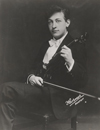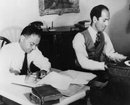Special Reports
Rising Stars in...Education
 Sarah Johnson
Sarah Johnson
Director, Weill Music Institute, Carnegie Hall
 With a staff of 23 and an endowed budget of $10 million, Sarah Johnson presides over one of the larger artsorganization departments devoted to education and community programs. For her, these resources, along with the international prominence of Carnegie Hall, mean increased responsibility. Under her leadership, the Institute’s first strategic planning process outlined three priorities: direct service, collegial support of the field, and generating new knowledge for the field. This means that, in addition to running its own programs, such as neighborhood concerts and residencies, Carnegie also vigorously investigates new areas of community engagement, and does so with evaluators and researchers on board to track impact and best practices. Carnegie then publishes and shares its knowledge. One example is its “Musical Connections” program, now going into its fourth season, in which teaching artists work in non-traditional environments, such as healthcare settings, homeless shelters, correctional facilities, and senior centers.“It’s a hot topic in the field, and we’ve presented at numerous conferences about it. There’s a lot to learn, and we wanted to be sure that we were making the best possible investments in order to have impact.”
With a staff of 23 and an endowed budget of $10 million, Sarah Johnson presides over one of the larger artsorganization departments devoted to education and community programs. For her, these resources, along with the international prominence of Carnegie Hall, mean increased responsibility. Under her leadership, the Institute’s first strategic planning process outlined three priorities: direct service, collegial support of the field, and generating new knowledge for the field. This means that, in addition to running its own programs, such as neighborhood concerts and residencies, Carnegie also vigorously investigates new areas of community engagement, and does so with evaluators and researchers on board to track impact and best practices. Carnegie then publishes and shares its knowledge. One example is its “Musical Connections” program, now going into its fourth season, in which teaching artists work in non-traditional environments, such as healthcare settings, homeless shelters, correctional facilities, and senior centers.“It’s a hot topic in the field, and we’ve presented at numerous conferences about it. There’s a lot to learn, and we wanted to be sure that we were making the best possible investments in order to have impact.”
Johnson received her training as an oboist at Juilliard. As a masters’ student, she gradually moved into being a teaching artist, through studies with Juilliard’s education guru Eric Booth, and her year as a Morse Fellow (“boot camp for teaching artists in the New York City public schools”). She founded a wind quintet dedicated to educational outreach and worked for several years as a teaching artist for the Lincoln Center Institute and the New York Philharmonic. “I wanted to have a greater impact on social challenges and problems in our society,” she says. Interested in “the role cultural institutions could play in communities,” she left the quintet and took an outreach job at the 92nd St. Y on Manhattan’s Upper East Side. In 2003, she went to the Philadelphia Orchestra as director of education and community partnerships, and in 2007, moved to Carnegie Hall.
Johnson’s roots as a teaching artist still inform her life. “I don’t play very much any more, but I feel very connected to that work when I’m in planning sessions with the teaching artists, or attending a three-hour music composition session at Sing Sing. It reminds me of the joy of a child or an adult having that moment of musical creativity.”





 FEATURED JOBS
FEATURED JOBS

 RENT A PHOTO
RENT A PHOTO


